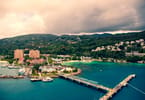Hurricanes, earthquakes, tsunamis, tornadoes, floods, drought, fires, snowstorms… these weather-related words have become part of our daily dose of news, our every-day conversations, our life on planet Earth.
Although technology and weather tracking has advanced, mankind still does not have a long-term crystal ball that can tell us when a natural disaster will occur. Yes, we are warned about hurricanes a few days in advance, with warnings about the potential of flooding, severe winds, loss of power, and people and businesses preparing the best they can within the span of those few days.
But is it human nature to hope for the best and wait and see? Apparently more so yes than not, as we witness natural disasters flattening buildings, knocking out power across entire islands, flooding and contamination of water supplies, roads being washed out, and airplanes being grounded. Is it that we are not prepared, or is it just an inevitable circumstance of living on a planet that is still relatively young and has growing pains like shifting tectonic plates, volcanic eruptions, and twirling masses of storms developing over the oceans?
Can we really be prepared for natural disasters, or can at best we be prepared for the rebuilding and recovery that will inevitably follow? Just how have destinations survived catastrophic attacks from Mother Nature and come back to fight another day and welcome tourists back?

Let’s look at Japan, hit by the most devastating natural disasters in this century, perhaps in mankind’s history. It was struck by a massive 9.1 magnitude earthquake on March 11, 2011, followed by a massive tsunami. The resulting numbers were staggering – 16,000 lives were lost, and tens of billions of dollars have been poured into rebuilding – rebuilding that is still ongoing 6 years later.
In the three Tohoku prefectures of Miyagi, Iwate and Fukushima, local governments and companies offer “recovery tourism” tours in which visitors travel through areas that were affected by the disaster. The tours are intended to raise interest and bring visitors back to Japan, but it is also meant to prevent memories of the disaster from fading.
In coastal regions, where the tsunami left scars that run deep, tourism has yet to recover. In the Miyagi Prefecture, tourism numbers are still down 40 percent compared to before the quake and tsunami struck. Especially in the hardest-hit areas, tourism is essential to create employment for those that return to resume their lives in the disaster-stricken regions.

Private companies are also using the natural disasters to boost tourism. For example, the Minami-Sanriku Hotel Kanyo located in Minami-Sanriku, Miyagi Prefecture, holds a bus tour for its guests every morning to places affected by the earthquake and tsunami. Hotel staff relates stories to tourists about how some of the people made it through those frightening initial first days. Already more than 100,000 tourists have taken the one-hour tour.
The Miyagi Taxi Association has drivers offering “storytelling taxis.” As they drive around the affected areas, electronic tablets are used to explain about the damage that occurred and what is being done to recover. The tour includes stops for passengers to get out and walk around the areas being described.

A farm tour offered by H.I.S. Co. provides a two-day, one-night tour at a farm that is working to overcome rumors about nuclear contamination in Nihonmatsu, Fukushima Prefecture. Tourists learn about the measures farmers are taking to ensure the safety of their produce, and also hear from local residents about what they are doing to recover.
So perhaps the way back for tourism in severely-affected areas after a natural disaster is to use the effects of the disaster itself to the region’s benefit. Beyond just taking tourists to see for themselves the aftermath of such devastation and listen to the stories, travel operators should offer more voluntourism opportunities where travelers can actually be involved in recovery. Many people find that doing meaningful volunteer work while also participating in tourism is a great way to get the best of both worlds.
.
WHAT TO TAKE AWAY FROM THIS ARTICLE:
- Is it that we are not prepared, or is it just an inevitable circumstance of living on a planet that is still relatively young and has growing pains like shifting tectonic plates, volcanic eruptions, and twirling masses of storms developing over the oceans.
- So perhaps the way back for tourism in severely-affected areas after a natural disaster is to use the effects of the disaster itself to the region's benefit.
- Yes, we are warned about hurricanes a few days in advance, with warnings about the potential of flooding, severe winds, loss of power, and people and businesses preparing the best they can within the span of those few days.






















